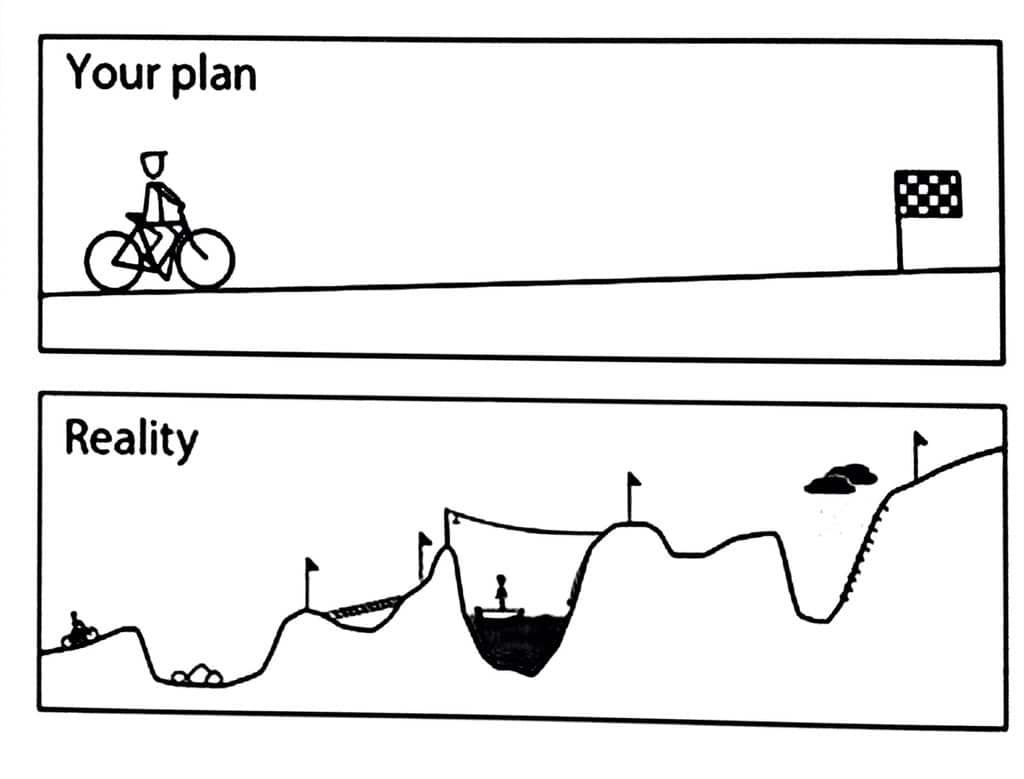There are few things in life more exciting than launching your own business.
But how to go about it? How to build a startup? Well, you probably know already that it’s going to be easier said than done. It is going to take your time, dedication, money, sleepless nights, and all you’ve got — until you make it.
Even with all that hard work, some people might not make it. Did you know that 70% of businesses fail within 10 years of starting? However, that doesn’t have to be you.
We’re here to tell you about some important ways you can increase your chances of success and speed up your journey.
For starters, make sure to read up online and understand the plethora of different issues you’re going to have to deal with, from the business plan itself to bureaucracy and the legal aspects of the business.
If you’re feeling overwhelmed preparing the launch of your startup, don’t be afraid — that’s completely normal. What’s more, just by deciding to go for it, you’ve already made huge strides forward.
Many, many people have game-changing ideas, but only a small percentage actually act on them. If you are one of those people who are ready but unsure of how to build a startup, we’ve created this list of five key things to think about.
#1 Identify the market problem and find a solution
When talking about how to build a startup, the majority of people focus solely on their ideas. However, while the idea is fundamentally important, it’s best to give your attention to the problem it solves. Try to describe the problem and see whether it actually exists on a larger scale.

Once you’ve done that, you can start devising your solution. Articulating the problem will most likely mean that you adapt your idea right then and there, in the early stages.
A detailed articulation of the problem will also give you a clearer picture of your potential business, the market you should be aiming at, and how you should angle your approach.
For example, the idea behind online streaming services is to provide vast amounts of content for around $10 per month, but the problems they solve are much more important.
Traditional cable TV is expensive for consumers. On top of that, they have to sit through ads and their choice of content is limited, both by the programming and by when they can tune in.
When you consciously use these problems as the backbone of your idea, you are able to improve your solution in just the right direction.
However, this is only the first step. To make sure you’ve done everything you can for your startup to succeed, craft a comprehensive, overarching business plan.
#2 Use the business plan as your startup compass
Beyond the fact that a business plan works as a great guide for you, it also means that your startup is almost twice as likely to secure funding compared to those without one.
To be precise, of those who start companies with a business plan, 36% secured a loan, 36% secured investment capital, and 64% grew their business — compared to 18%, 18%, and 43% respectively among entrepreneurs with no business plan. Those numbers speak for themselves.
So, what exactly does a startup business plan consist of?
Well, while there is no one universal business plan structure, there are a few staple elements that all business plans include. Those elements will serve as your guides in this journey.
Once you complete your business plan, you’ll know not only how to go about starting a startup, but exactly how to start YOUR startup.
Our one-page business plan feature is the perfect way to quickly get going.
Begin with market research
Market research should be the first step you take after outlining the problem your startup will solve.
What is the size of the market? What is the growth stage? Where does your product fit in? How much are customers spending on the alternatives?
Look around to see if anyone out there is trying to solve the same problem. How different is their solution to yours? What are their weaknesses and their strengths? Is there something missing that your solution could provide? Consult experts in the field. Talk to them about their experience, your competitors, and your idea.
Market research should give you a clearer idea of your potential and help you finesse your solution. From there, it’s time to define your ideal customer and the problem they have that your solution can help address.
Identify your target customers
As a startup, chances are your budget will be pretty limited. This means it’s important for you to define your target customers and, according to that, create your unique selling proposition.
We’ve talked before about Uber’s target customers. They aimed for busy urban people who have trouble finding easy and convenient means of transportation. Now, imagine if instead, they poured all their startup budget into marketing to anyone and everyone, without differentiating themselves from say, taxis.

Sure, they’d get some customers. But, many of the customers attracted this way might find their service unnecessary, expensive, or inconvenient — possibly even leading Uber to put significant energy into developing their product for the wrong market. In this case, the company would not have lasted very long and wouldn’t be a byword in society today.
Your starting point is to choose your market and then focus on a niche within that market. Find places online and out in the world where your target customers gather. Research your competitors and their customers. Analyze them according to their demographic data, their quirks, the challenges they are facing, and the goals they want to meet. Better yet, engage with them directly. Consult them about their concerns and desires, build relationships, and get their input on possible solutions.
These steps are crucial not only to developing your idea but to find your product-market fit, another backbone for the validation of your idea.
You need to know why the glove fits better than that of your competitors, as well as who it’s meant to fit before you start selling it.
Define your business model
A question that pops up early on when planning how to start your startup is what you need to do to secure funding. One of the most important aspects of securing investments is to identify your business model early on. Where will your revenue come from?
Will your business model be subscriptions, usage fees, licensing, advertising, or something else? How much will your customers have to pay for your product? In addition, it’s a great idea to set some goals and sales estimates for your efforts to be as effective as possible.
And when you have defined your goals, it’s time to see where you’ll invest your money in order to reach them.
Create marketing and sales plan
Before you start working on your marketing and sales strategy, you need to get to know your target customers and identify where you can find them online. Analyze your sales targets and try and allocate the marketing and sales budgets you’ll need in order to meet them.
With a limited budget, you’ll have to spend in the right places, targeting the right people with the right messages to make your efforts effective and secure the best ROI.
Study up on the basics of marketing if you haven’t already done so, and try to answer these questions:
- What platforms are the best for reaching your target customers?
- What promotional message will resonate with them?
- How much money does it take to acquire a customer?
On your own, you should be able to come to some conclusions. However, you should definitely take time to reach out to marketing experts and possibly even get them to join your team.
Surround yourself with a rocking team

Depending on how far you’ve got, you might already have teamed up with a few co-founders in your startup — and that’s great. However, if you’re the sole founder and have no one on your team yet, you’ll still go through the same process.
Take note of the team you have right now, and see what your weaknesses and strengths are.
Is one of you a marketer? Perfect, you might not need a senior marketer right away. Is one of you a developer? Cool, they’ll best know what type of developer you need to seek for your team. The key roles in areas where you have the least collective knowledge should be the first people you hire.
And how many people do you need on your team? That varies from business to business. Consult your business plan, your mission, and your goals, and identify the key people your team should include when building your startup.
Finally, don’t forget about all the bureaucratic stuff. If none of you are experts in accounting, law, or finances, consider hiring some external consultants to help you out or make use of an online accounting test to assess the skills of your potential talent.
Get your startup funded
To be able to start your startup, you’ll need to have capital. How much?
That will depend on your particular line of business. What equipment, personnel, and facilities do you need to have to be able to start? How much will that cost? These will be your startup costs.
When you actually get down to it, these costs may be higher than you anticipated at first. But don’t let this get in the way of your dreams, there are many funding options out there.
The majority of US startups are funded out of the entrepreneur’s pocket, followed by friends and family — and only after that do VCs, angel investors, and banks come into play.
If you opt for these external funding options, be sure to have your full business plan — and more importantly, the financial plan — completed.
Given that 82% of businesses fail due to poor cash management, you’ll need to have your financials completely in order for someone to actually invest in your startup.
If you’re struggling to create a unified, comprehensive business plan, you can try IdeaBuddy for free and cover all the essential elements of a business plan, including the financials, in one place.
#3 Launch a minimum viable product (MVP)
After you have everything in place after a couple of months of work, it’s time to launch your minimum viable product. It’s the first usable prototype of your product.

Its only purpose is to test out the waters before you pour all your money into building the actual, full-featured product. Don’t work day and night and spend all your money on building a product that no one wants to use when it’s done — the startup nightmare scenario.
The fact that your MVP is a test run means it’s not something you should try to pack as many features as possible onto. It’s only important that it solves the main pain points your target customers experience, at the same time demonstrating its value to your investors.
Talk to your target customers, onboard them as Beta testers, and use their feedback to refine your product development roadmap. You’ll find out what they like, what they need, and what they would value the most.
As your actual target market, they’ll help you design the best product possible.
#4 Get the first 100 customers for your startup
After you’ve tested out your MVP and seen whether it’s going in the right direction or a pivot is needed, it’s time for you to start getting your first actual customers.
Draw on everything you’ve learned so far. You’ve been learning how to build a startup, and now it’s time to apply what you’ve learned on a larger scale.
You now know your target customers, you know their pain points, and you have refined the main messages you’re sending. Have all of these in mind when creating your website, your social media presence, and your ads.
Don’t forget about your beta testers. As your target customers, they are most likely surrounded by people with the same pain points. Encourage them to share your product with people in their industry, as referrals will be one of your best sources of customers at this stage.
Listen to their feedback and adapt your product accordingly.
#5 Prepare for a rough ride
Ultimately, it’s important for you to know from the outset that things will not be easy. You’ll face a variety of challenges and obstacles throughout your journey.

Over the course of time, the majority of businesses face intermittent cycles of expansion and recession, sometimes due to their own mistakes and sometimes because of factors completely out of their control. However, what’s important is that you don’t let the setbacks you encounter steer you off your course.
A successful entrepreneur is always prepared, always has a plan, and learns from their mistakes — and investors love seeing this. If you’d like a simple, time-saving way to create your comprehensive business plan and keep it updated, you should try IdeaBuddy.
It’s a handy, convenient business planning software that will help guide you in the right direction based on your data input.
Create your free account today!



